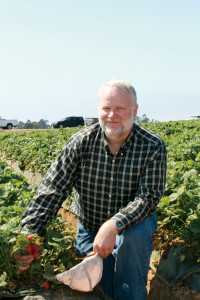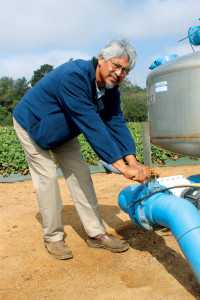California Strawberry Grower Trials Raised Bed Growing System
Editor’s Note: American Vegetable Grower attended a California Strawberry Commission field day last summer in Watsonville, CA, devoted to the Raised Bed Trough (RaBeT) Substrate Growing System, which was in year three of a four-year trial. Then, this past winter, we reconnected with the grower whose field was used for the trial, Miguel Ramos. Having had time to digest his experience with the system — and total the numbers — he graciously shared his impressions.
Growing strawberries in California used to be a lot simpler when methyl bromide was easy to get, not to mention cheap. But since the phase-out of the powerful fumigant began following the Montreal Protocol, farming berries is becoming a lot more complicated. For example, last year California growers produced 88% of the U.S. total on 40,000 acres, but there are Critical Use Exemptions (CUE) this year for just 10,000 acres.

Grower Miguel Ramos and the production research manager for the California Strawberry Commission, Hillary Thomas, show some of the strawberries grown with the Raised Bed Trough (RaBeT) Substrate Growing System. Photo credit: David Eddy
Miguel Ramos can use methyl bromide on some of the 42 acres of strawberries he farms on two ranches in Watsonville. On most of the rest of his acreage he will use another fumigant, such as Pichlor 60, to rid the soil of a whole host of diseases, such as Verticillium, Phytophthora, etc. But because he “sees the writing on the wall” for fumigants, he has devoted 1 acre to a trial on a system being tested by the California Strawberry Commission called Raised Bed Trough (RaBeT) Substrate Growing.
RaBeT involves covering the bed with a cloth impenetrable to plant roots so the crop is grown not in the field, but just above it in a soilless medium. (See “7 Easy Steps.”) The medium is a mixture of coconut coir and peat moss. Researchers started out growing the plants only in coconut coir, a technique used in many greenhouses. But the commission’s production research manager, Hillary Thomas, says trials conducted on strawberries using 100% coir showed the plants didn’t do as well as when combined with peat moss. “We don’t know why,” she says. “Some thought there may be salt issues, but that didn’t prove true.”
The Pros
Exposing the plants’ roots to less salt is one of the definite advantages to the RaBeT system, but there are also disadvantages. First off, the former.

Dan Legard, director of research for the California Strawberry Commission, says the Rasied Bed Trough Substrate Growing System is labor intensive, requiring additional management. Photo Credit: David Eddy.
- Dan Legard, the commission’s director of research, says yields tend to crash when the electrical conductivity of the soil gets too high, like the 4 to 5 range.“You drop it back down to 2, and boom, no problem, with this RaBeT system you can wash the salts out easily,” he says. “The yield performance at the end of the year usually is much better than the grower standard because there’s so much less salt.”
- You fertigate several times each day because the coir/peat mixture doesn’t hold nutrients like soil. One benefit of that is not only can you really spoon feed the plants, you can cut your nitrogen applications down to near zero, says Ramos, and you don’t have to worry about runoff or nitrate leaching.Thomas agrees, noting that the growing medium holds only about 20% of the nutrients that soil holds. “You can look at that as a problem — or you can take advantage of it,” she says. “Spoon feeding is always better.”
- Ramos says his conventionally farmed plants, where he uses methyl bromide, need 20% more fertilizer to achieve the same plant health. There is also greater insect control. “Because the plants are continuously fed there is less mite damage,” he says, “because mites don’t like a healthy plant.”
- Thomas points out that it takes a different mind-set on the part of the grower because the substrate has no native nutrition. Because of that, Ramos says harvest can be delayed under the RaBeT system for one or two weeks. But that’s not necessarily a bad thing. “The real issue is getting the yields, not the timing of the harvest,” he says, “because you can’t control the market.”
Click on the next page to read more…
The Cons
After the season ended, Ramos shared his results. The berries were of excellent quality, and while yields were down a little, the difference was slight. But not so the costs. “The expenses were very high, and we haven’t been able to reduce them,” says Ramos, who added that virtually all the disadvantages to the RaBeT system have to do with the expense.
- First, there is the cost of the substrate itself. It took an awful lot of peat/coir, even for just 1 acre. They applied 60, 1,400-pound bags of the mixture, which besides being expensive, amounted to a lot of work.
- Another material that doesn’t come cheap was the special canvas-like fabric which prevents the substrate from touching the soil. If the roots were to touch the soil, it would make the system pointless.
- The computerized drip system requires specialized equipment, including the pumps. “You must maintain the right balance of nutrients, which is programmed into a computer,” he says. “How much N, for example; the computer will then increase or decrease the amount according to our wishes.”
- Even the drip tape is more expensive, says Ramos. It has to be thicker, and able to open and close at a certain pressure. “The system has to be pressurized all the time,” he says, “and you can’t do that with regular drip tape.”

Watsonville, CA, strawberry grower Miguel Ramos says the Raised Bed Trough Substrate Growing System requires specialized equipment like this pump to keep the system pressurized. Photo Credit: David Eddy
7 Easy Steps
Raised Bed Trough (RaBeT) Substrate Growing sounds unfamiliar and kind of strange. But keep in mind that growing systems of this type have been tested for several years. Here’s a look at how to set up a field-installed system.
- The bed is prepared, or listed, with a large tractor to form a soil bed with one or two troughs.
- The bed is lined with landscape fabric.
- The bed is filled and packed with prepared substrate. A peat/coir blend is used now.
- Prepare the leachate collection system.
- The drip system is installed using pressure-compensating drip emitters.
- Plastic mulch is installed over the bed.
- Plants are fertigated consistently throughout the growing cycle.
Source: California Strawberry Commission
Judgment Day
There’s no question the system is not for everyone, says Legard. “Growers are like ‘What did you get me into?’” he says with a chuckle, “because RaBeT takes a lot more work.”
In fact, Thomas says that a grower will likely need some help in farming with modern systems such as RaBeT. “These systems are going to require more management; you have to watch them, you can’t just drive by in your truck once a week,” she says. “For example a clogged drip line will cause you more problems. But by the same token you have a lot more control.”
Ramos says that control comes with a price tag, and though the costs of RaBeT are extremely high, it’s still very much in the experimental stage. As with virtually any new technology, as it’s employed more often, costs could come down. And you have to weigh the benefits, such as the fact that you don’t have to worry so much about urban encroachment and its attendant buffers against fumigated fields. Or perhaps your soil is not suitable. “You have no choice if you have soil infected with Fusarium,” he says. “In that case, it’s a good alternative.”
Because growers might not have many choices in the future, Ramos says they need to educate themselves about alternative farming systems such as RaBeT. “I would encourage growers to start experimenting with it,” he says, adding that they will have to eventually adjust to farming without fumigants, “because the day is coming.”









